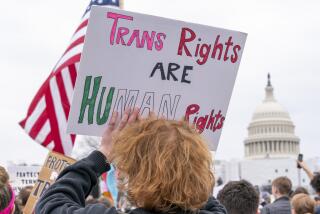In surprise move, Supreme Court to hear healthcare law challenge

- Share via
Reporting from Washington — The Supreme Court put President Obama’s healthcare law back into legal peril, announcing it would consider a conservative group’s claim that the law does not allow the government to subsidize health insurance for low and middle-income Americans in two-thirds of the states.
The announcement surprised legal observers who had expected the justices to wait on the issue, at least until a court of appeals here had finished considering it. Friday’s decision to quickly move ahead provided a strong indication that at least four justices remain determined to undo central elements of the law.
Two years ago, the court’s conservatives came one vote short of striking down the Affordable Care Act on an issue of high, if abstract, constitutional principle. The new challenge, by contrast, involves just five words in the lengthy statute and what many of the lawmakers who wrote it have described as little more than a drafting error.
The key vote now, as it was in 2012, probably will be that of Chief Justice John G. Roberts Jr. In the previous case, he broke with the conservatives to uphold the law in a 5-4 decision.
The latest case goes to the heart of the law, which requires most Americans to have insurance and provides billions of dollars in tax subsidies to help low- and middle-income people afford it. This year, single adults with incomes up to $45,960 a year and families of four with incomes up to $94,200 can get help.
At issue is whether the law, as written, limits those subsidies to policies bought on an “exchange established by the state.”
Some states, including California, have set up such exchanges. This year, 38 states have chosen not to do so, put off by the cost and complexity of the effort or by political opposition. Those states rely on marketplaces operated by the federal government.
The law says federal officials may run an exchange on behalf of a state. But it does not clearly say that the subsidies may flow through such federally run exchanges.
The case could have major impact. This year, nearly 5 million people have purchased subsidized insurance in states using the federal exchange.
Some health insurance experts have said the law cannot work if low- and middle-income citizens cannot get help affording insurance.
In most states, a large majority of those buying insurance qualify for subsidies. For example, in Illinois, which uses the federal exchange, about three-quarters of the roughly 200,000 people who enrolled in health coverage this year qualified, according to the Department of Health and Human Services. The subsidies reduced average monthly premiums by more than $200, from $316 to $114 a month.
In other states, the reductions were even more dramatic. In Mississippi, the average monthly premium without a subsidy would have been $438. With subsidies, consumers in the state pay an average of $23 a month.
When Democrats wrote the law in 2009 and pushed it through the House and Senate, they assumed almost all the states would set up an exchange, or online marketplace, to help consumers shop for insurance. That proved be a political miscalculation.
Administration lawyers and other defenders of the law say, nonetheless, that the law’s intent was to provide insurance subsidies nationwide. Officials in states that decided to use the federal exchanges did so assuming their residents would be entitled to the same subsidies others get, the law’s backers point out.
But a small conservative group based in Washington, the Competitive Enterprise Institute, contended that the literal meaning of the law was otherwise. The group launched several lawsuits.
They lost in federal district courts in Washington, D.C., and Virginia, and then in the 4th Circuit Court of Appeals, based in Richmond, Va.
Washington attorney Michael Carvin, who led the constitutional challenge two years ago, is leading the new case. In July, he appealed the 4th Circuit ruling in King vs. Burwell and urged the justices not to wait for a final ruling by other appellate courts. “The longer the lawless … rule is in effect, the greater the upheaval when it is ultimately vacated,” he told the justices.
This summer, a three-judge panel of the U.S. Court of Appeals for the District of Columbia Circuit sided with Carvin on the issue. But the full D.C. Circuit later voted to reconsider the case next month. Many legal experts had expected the Supreme Court to wait to see how that case turned out.
Congress could, of course, clear up any confusion by amending the law, but stalemate over the Affordable Care Act has made any such efforts impossible.
The court does not reveal how many justices vote to hear a case, but its rules require at least four. The dissenters from 2012 — Justices Anthony M. Kennedy, Antonin Scalia, Clarence Thomas and Samuel A. Alito Jr. — made clear they were fiercely opposed to the Affordable Care Act, and they probably cast the votes to hear the new challenge.
The court’s four liberals — Justices Ruth Bader Ginsburg, Stephen G. Breyer, Sonia Sotomayor and Elena Kagan — are likely to stand solidly in favor of the law and its nationwide insurance subsidies.
Sam Kazman, general counsel for the Competitive Enterprise Institute, called the court’s announcement “excellent news, regardless of which side you’re on. The need for a quick and final resolution of this question is undeniable.”
White House spokesman Josh Earnest called the suit “partisan.”
“We are confident that the Supreme Court will recognize both the clear reading of the entire law and the certain intent of Congress in crafting it,” he said.
The Supreme Court will hear arguments in the case early next year and issue a decision by late June.
Times staff writer Noam M. Levey contributed to this report.
More to Read
Inside the business of entertainment
The Wide Shot brings you news, analysis and insights on everything from streaming wars to production — and what it all means for the future.
You may occasionally receive promotional content from the Los Angeles Times.











